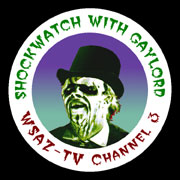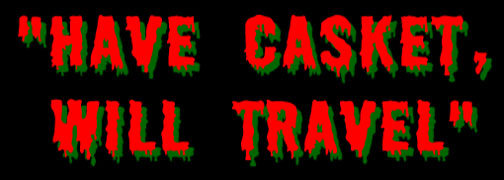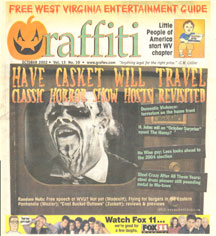

APPALACHIA AFTER MIDNIGHT
West Virginia Horror Hosts Revisited
By Kurt McCoy
(Reprinted by permission of the author from the October 2002 issue of Graffiti,
the "Free West Virginia Entertainment Guide")
As midnight crept nearer, an eerie darkness filled the house. The wind moaned and bare branches scratched at the windows like skeletal fingers. The blue glow of the black and white television cast flickering shadows around the room. Finally, the familiar music began, wild and shivering, with groans of organs and peals of bells.
A host appeared — a pale ghoul in a black top hat and cape — eager to guide me to the darkest of terrors, to paint the night with silver and gray phantoms, to splash credits, blood red or slime green, across my screen and laugh at the commercials that dared interrupt his revels. Somewhere between vaudeville and nightmare, these ghouls ruled weekend TV for more than three decades.
The Horror Host show is a slice of American popular culture that has all but faded into extinction. These were costumed characters who introduced horror films, usually on late night local programs. Virtually every market in the country had them and they were a staple of weekend TV for a generation of rabid fans.
"If you love those kinds of movies — and me and my friends did, you didn't miss the shows on Friday or Saturday nights," says filmmaker Danny Boyd, who grew up in Martinsburg, West Virginia. "We only had four channels and we watched any horror film they had on. They were all bad '50s, low-budget films — but we loved them all.
"That was the beginning of my love of films of the fantastic," he added. "Kids today have thousands of movies to choose from — back then, we only had dozens. Those were the building blocks for horror fans — and for horror filmmakers. One of the most memorable moments in my life was when I was 6 and my dad woke me up to watch Frankenstein."
Once upon a time, television stations offered a range of locally-produced shows, now replaced by syndicated packages or expanded network broadcasts. The shows included western theaters (introduced by "cowboys"), jungle theaters (hosted by Tarzan-wannabes or pith-helmeted adventurers), children's shows (with clowns), all with hosts who became local personalities. The horror movie shows were another piece of the local broadcasting scene. Often, the same performers would do double duty, portraying a clown on Saturday mornings and a ghoul on Saturday nights.
The art of hosting horror films was pioneered by personalities like VAMPIRA and ROLAND, but the national craze began when the original Universal Monster movies were released to local broadcasters in the late 1950s. The classic movie monsters were marketed in a package called "SHOCK!" A second "SON OF SHOCK!" package soon followed. The national publicity campaigns often featured costumed performers and ghoulish gimmicks meant to amuse station managers. The booklets suggested that stations create their own costumed hosts to present the films and preside over the show between commercials. A great many stations did exactly that and horror host shows popped up in major cities all across the country in 1957. The shows were wildly popular and spawned a monster boom that lasted from the late '50s through the '60s.
"Shock!" came to West Virginia in 1959. The first local station to acquire the package was Huntington's WSAZ, Channel 3. The station's regular 11:15 p.m. movie show, "Nitewatch," began mutating into something more sinister than the suspense, thriller and war pictures that generally aired in that time slot. Newspaper ads warned "faint hearts" NOT to watch The Neanderthal Man. The next week's ad warned, "If you thought The Neanderthal Man was gruesome, wait 'til you see The Creeping Unknown!" The next two months brought films like The Beast with 5 Fingers, UFO and Sabaka (featuring Boris Karloff), with the steady stream of horror movies culminating in the Fourth of July presentation of Frankenstein, the flagship of the "Shock!" package.
Have Casket, Will Travel
Along with the introduction of the "Shock" movies, WSAZ also unveiled the host of its new show, a ghoulish figure with sunken black eyes in a craggy white face, dressed in black cape and top hat, named GAYLORD. The Saturday night show was dubbed "Shockwatch" and a new weekend ritual for Huntington horror fans was born. The highpoint of "Shockwatch" was its first Halloween special — a double feature of House of Horror and Dracula. Costume contests and a Halloween celebration ran into the wee hours.
Gaylord was played by WSAZ news announcer Fred Briggs. His character, like many of the early hosts, was grimly sardonic and deliberately ghoulish. He played the keyboards and cracked bad puns with gravelly sincerity. His motto was "Have Casket, Will Travel!" He was West Virginia's first homegrown horror host but his reign didn't last long. In addition to portraying Gaylord, Briggs was a talented newsman. In less than two years, he left WSAZ to work as a reporter and anchorman for WSB-TV in Atlanta. He went on to be a correspondent for NBC and won an Emmy in 1969 for his reporting on black lung disease. Gaylord lived up to his motto and traveled with his casket to WBFF in Baltimore. While working for that station, he revived his ghoulish alter ego during the early '70s. This new Gaylord show was produced by George Lewis, who would go on to create his own horror host character in the very popular GHOST HOST show. Briggs had a long and distinguished career as a news correspondent, appearing on NBC broadcasts up until the late '80s. He died of cancer in 1995 at the age of 67.
WSAZ dropped "Shockwatch" after Briggs departed. Rival station WHTN picked up the horror audience with "Chiller" on Friday nights and "Chiller Theater" on Saturday nights. The latter aired until around 1967. These shows were, according to the memories of those still working at the station, routine movie shows with voice-over announcing.
The Mystery of the Missing Monsters
The popularity of "Shockwatch" spawned other shows. Unfortunately, little footage or photos remain to document their existence. Viewers remember that WHTN did have a horror host sometime during the '60's. Dan Terango has been mentioned as being connected with that show. Bob Bratton at WCHS remembered working on shooting intros, bumpers and end credits for a show at his station, but the details have been lost.
Of Man and Myna
C. J. "Tiny" Thompson, a longtime news announcer on WHIS in Bluefield, also appeared in a show broadcast from Roanoke's Channel 10. On that show, he introduced films from the "Shock!" package wearing a white shirt with a black Myna bird perched on his shoulder. An eerie spotlight picked him out of the blackness and fog of a very basic set. His deep, sepulchral announcer's voice made a mark on the memories of several Roanoke viewers, most of whom believed the bird on his shoulder was a "raven." When asked about his own memories of the show, Thompson recalled doing it, but not much else. "That was more than 40 years ago!" he said. "I'm 72. I'm lucky to remember where my own house is day to day."
The Outsiders
While West Virginia had its cast of horror hosts, most of the shows recalled by viewers originated outside the state. In the Northern Panhandle and North-Central WV, shows from Pittsburgh, Pennsylvania, seem to be the most memorable. SIR ROGER came first, then CHILLY BILLY Cardille's Chiller Theater, which lasted from 1963 until 1983. Channel 53 had Scream-In which featured two vampire hosts, COUNT COAGULUS followed by COUNT VON THIRSTENBURG (rumored to be the inspiration behind Joe Flaherty's COUNT FLOYD character on the SCTV comedy show) and finally by TARANTULA, a sort of hip occultist who lasted until the show (and the station's) demise. SCORPIO appeared on a revived Channel 53 show in 1976 and lasted about a year. During the early '80s, George Lewis' GHOST HOST was syndicated through a Pittsburgh channel.
Residents of the Eastern Panhandle were fortunate enough to bask in Baltimore / DC's rich horror host scene. The GHOST HOST, COUNT GORE DE VOL, THE BOWMAN BODY and SIR GRAVES GHASTLY were just a few of the hosts in that region. The central part of the state received mostly shows from Ohio, which has one of the richest traditions of hosted horror shows in the country. Dayton's DR. CREEP, with his ghoulishly jolly "Woo-ha-HAH!" laugh and fanged grin beamed into the Huntington / Parkersburg area. SAMMY TERRY, scarlet-clad, green-faced ghoul from Indianapolis had a show that reached all the way across Indiana and Ohio to tickle the shivers of fans from Huntington to Charleston. The SON OF GHOUL show, which is still on the air, has a loyal following in parts of the north and central markets. SINISTER SEYMOUR's "Fright Nite" was syndicated in Charleston during the mid-'70s.
The Biggest Name in Mountain State Monsters
More than any other single factor, the creation of "Saturday Night Live" at NBC sounded the death knell for the hosted horror film shows. The late-night slot was the traditional time for many shows across the nation. When NBC filled that slot with its own comedy broadcasts, numerous shows were bumped back in later starting times or canceled outright. Audiences dropped off and the shows that remained had to adapt to tighter and tighter budgetary restrictions.
All of which makes the emergence of the next WV horror host of note in the early 1980s all the more unusual. When a new owner took over WVAH-TV, plans were made for a Friday late night show. That show became "Friday Night Dead" and featured the talents of veteran radio personality Al Sahley as FAT DRAC, "the King of Corpuscular Corpulence! The biggest name in Mountain State monsters!" Sahley was working at the station doing voice-overs and promos when the idea for the Friday night show was hatched. A self-professed "ham" with a talent for vocal characterizations and imitations, Sahley had always wanted to do a Dracula character and the new show gave him the chance. The debut of "Friday Night Dead" (an ironic counter-point to "Saturday Night Live") was broadcast live. Sahley and production manager Steve Utt (who currently works for Fox 11 / WCHS) pulled together the costume and set, which included a plywood backdrop of castle walls and bats painted by Lorna Wayne and a shipping coffin (little more than a wooden box lined with felt).
That first night proved to be an exhilarating and harrowing experience. From then on, "Friday Night Dead" was taped on Wednesdays, to allow some time for editing and general refinement.
The show maintained its feeling of spontaneity, since Utt and Sahley never really scripted the shows. They sat down together just prior to taping and roughed out the gags and segments that were then half-improvised by Sahley. Special effects were conjured up by Utt, more or less on the spot, and provided memorable moments like Fat Drac performing "surgery" with cauliflower "brains." Other cast members included a man with a glass eye and very distinctive features who was done up in scar-face makeup with a noose hanging around his neck, and one of the ladies from the station's front office who was convinced to don a black negligee and lie in the coffin. The show was quite a success with fans writing in from as far as central Ohio and across the state.
After that memorable first show, a tired Al Sahley decided to drive home before getting out of his costume and makeup. So, after 1 a.m., with his cape streaming from the moon roof of the car, "Fat Drac" pulled up to a pair of hitchhikers trying to flag down a ride. The car window rolled down and a ghastly white face with fangs and slicked back hair loomed out of the darkness inside the car. Sahley, in his best over-the-top Transylvanian accent said, "Good evening! Vould you care for a ride?" The two hitchhikers let out a shout and took off running.
To this day, 20 years later, Big Al still gets a chuckle out of that memory.
And for all we know, 20 years later, those two hitchhikers are still runnning!
|
The October 2002 issue
Thanks to Kurt McCoy
Read lots more in
|
Posted March 15, 2005 by George "E-gor" Chastain.
E-mail E-gor!
